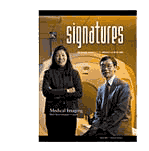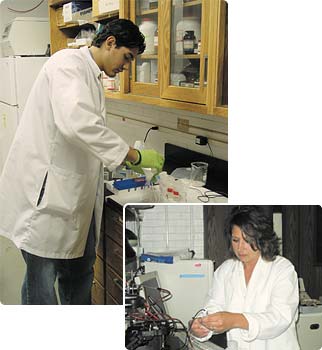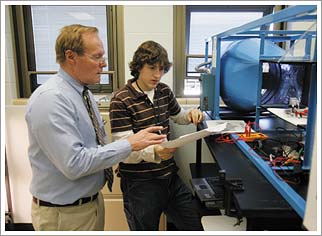
 |
 |
There’s an old joke that
recounts a young man’s first visit home after a semester of college
in the big city. His father gives him a bear hug welcome and then asks
him to share something he has learned. The boy pulls himself up as
straight and tall as he can, looks his father in the eye, and proudly
says, “πr2.” Well, the father, who didn’t go to
school himself and had sacrificed much to be able to send his son to
college, explodes. “I don’t understand how they could teach
you something like that,” he says. “Everyone knows pie
are not square! Pie are round. Corn bread are square.” The truth
for an engineer as he or she works to find solutions to real-world
problems often lies somewhere in between “round” and “square,” where
conventional knowledge meets creative application, but far from the
misconceptions people nurture about technology and those who make it
work. Misunderstanding
has long plagued engineering, and society has often labeled engineers
as square pegs — brilliant but nerdy. According to Pat Remick
and Frank Cook, the authors of 21 Things Every Future Engineer
Should Know: A Practical Guide for Students and Parents, these
wrong ideas are taking their toll on the next generation. Many of the
country’s most promising students are not considering careers
in engineering because of these misconceptions. They think it’s
too hard to be an engineer and that other majors may be less demanding.
Mostly, they do not understand what engineers do or how profoundly
they impact daily life. Misunderstanding
has long plagued engineering, and society has often labeled engineers
as square pegs — brilliant but nerdy. According to Pat Remick
and Frank Cook, the authors of 21 Things Every Future Engineer
Should Know: A Practical Guide for Students and Parents, these
wrong ideas are taking their toll on the next generation. Many of the
country’s most promising students are not considering careers
in engineering because of these misconceptions. They think it’s
too hard to be an engineer and that other majors may be less demanding.
Mostly, they do not understand what engineers do or how profoundly
they impact daily life. Obviously, engineers have to be able to comprehend the complicated math and science that is so intertwined with the profession. There are theories and algorithms they need to be able to employ, concepts they need to be able to understand. An engineer who is not technically proficient is not going to make much of an impact. But, as Remick and Cook point out, the most important thing to know about engineers is that they are problem-solvers, which means that in addition to “book smarts,” they need to be inquisitive, creative, and motivated. While 21 Things offers insights into engineering disciplines, career paths, and college programs, the University of Notre Dame has taken a more interactive approach to changing some of the misconceptions about engineering, one that highlights the ingenuity, curiosity, and activities that are as much a part of being an engineer as is a good grasp of math and science. Several departments within the University have developed educational outreach programs that allow students — and their teachers — to experience engineering and technology up close and personal. Two of these programs are Research Experience for Undergraduates (REU) and Research Experience for Teachers (RET). In the REU program undergraduates from universities across the country spend the summer, eight to 10 weeks, at Notre Dame conducting hands-on research under the supervision of Notre Dame faculty and alongside graduate students and other undergraduates. They gain experience and are able to explore a particular field in more depth than is possible during the academic year. Sponsored by the National Science Foundation, the REU program also requires participants to make a formal presentation of their research, which hones their communication skills. |
||
 |
<< Undergraduates, high school teachers, and high school students benefit from College of Engineering outreach programs. Jose Roberto Diaz, a student at the Mayaguez campus of the University of Puerto Rico, worked with Robert Nerenberg, assistant professor of civil engineering and geological sciences, and Jeremy B. Fein, professor of civil engineering and geological sciences and director of the Environmental Molecular Science Institute, on a project titled “Cadmium Adsorption by Mixed-culture Biofilms under Metabolizing and No-metabolizing Conditions.” Lisa Vukovits, a science teacher at Washington High School in South Bend, Ind., also worked with Fein to determine the nature and extent of the adsorption of heavy metals and radionuclides onto bacterial surfaces. |
|
Although many
of these students are already in engineering programs, REU helps them
identify their specific interests while confirming their choice to
pursue engineering. Nationally, this is important as up to 60 percent
of the students who enter college as engineering majors leave the program
before graduation. (Notre Dame’s
average, at 40 percent, is much lower. The College of Engineering’s
graduation rate from sophomore year to senior year is 90 percent.)
The difference, according to many of the students, is being able to
work as an engineer with faculty and other students on high-profile
research projects. |
||
 |
<< Nevin Longenecker, a science teacher at John Adams High School in South Bend, Ind., talks with junior Joseph O’Rourke in one of the school’s labs. O’Rourke’s project, “Managing Gas Evolution and Reduction and Other Factors in the Direct Methanol Fuel Cell to Increase Power Output,” was funded by the Indiana Academy of Science. | |
| Nevin Longenecker, who
teaches science at John Adams High School in South Bend, Ind., spent
his summer researching basic concepts related to fuel cells, specifically
microbial and enzymatic fuel cells. Working in the laboratory with Robert
Nerenberg, assistant professor of civil engineering and geological
sciences, Longenecker designed, built, and tested a prototype fuel
cell — one that could also be constructed and used in classrooms. Although Longenecker did not work on a specific research project with them, he also credits Valli Sarveswaran, education and outreach administrator for the Environmental Molecular Science Institute, and Alex Hahn, professor of mathematics and director of the Kaneb Center for Teaching and Learning, for his positive experience and the success of the program. “The RET program has benefitted me and my students,” says Longenecker. “I have become more familiar with various types of equipment, which can be used to test and improve the efficiency of fuel cell prototypes. As important, the principles of my work on fuel cells (circuitry, enzyme action, electroplating, and electron transfer) are widely applicable to other investigations that my students are performing.” Longenecker has six students working on the principles underlying the operation of fuel cells and a total of 18 students conducting sophisticated science investigations ... four of which are funded by the American Association for the Advancement of Society. “This is so exciting for a teacher to see,” he says, “and I am confident that their experiences will encourage them to pursue careers in technology.” Not concerned with “round” or “square,” Longenecker and the other RET participants are the best examples their students could have. They are debunking the misconceptions about engineering and technology and instilling in their students a curiosity for how things work and a love of learning that will prepare them for college and beyond. Information on REU and RET opportunities for 2007 can be found on each department’s or center’s Web site. Simply visit the College of Engineering site (www.nd.edu/~engineer) and click on Departments/Centers. |
||